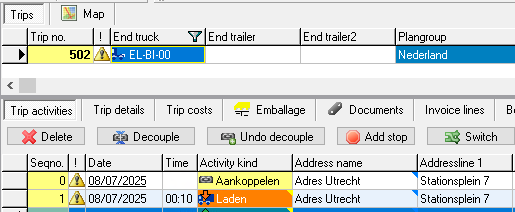
As of January 1, 2025, municipalities in the Netherlands are allowed to introduce zero-emission zones. In these areas, all freight traffic must be completely emission-free. In addition, various environmental zones exist with specific restrictions, such as zones where only trucks with a certain emission class are allowed or areas where vehicles above a certain weight are prohibited. Violating these rules can result in hefty fines.
To prevent trucks from entering zones where they are not permitted under these regulations, Transpas Enterprise offers the option to automatically alert planners. By linking capabilities to vehicles in combination with defined zero-emmision zone regions, a planner will receive a notification when a trip is planned that involves loading or unloading within an zero-emission zone.
¶ Importing zero-emission zones
Zero-emission zones are imported by creating geographical areas within a region, where an area is defined by a series of GPS coordinates. Although these areas cannot yet be edited interactively, Transpas does offer two convenient import options:
Navigate to the "Regions" screen. The zero-emission zones will be added to the currently selected region. Most likely, a new region will need to be created first.
-
Import from NDW Environmental Zones
-
Download the file "Emissiezones.xml.gz" from opendata.ndw.nu.
-
Extract the file to an XML file.
-
Import the XML file using the action button "Import NDW environmental zones".

-
Then select the desired areas from the displayed list. Note that areas starting with "ZE" are zero-emission zones (not to be confused with LEZ zones).

-
Note: the data from NDW is made available as open data. Transpas cannot guarantee the completeness or accuracy of this data. Users are responsible for verifying and interpreting the imported information.
Example zero-emission zone Utrecht

-
Import from GEOJSON file
- Within the "Geographical Areas" tab, create a new entry and provide a clear description (e.g., "Zero-emisson zone Utrecht").
- Right-click in the text field, select "Import from text", paste the GEOJSON data into the pop-up window and click "Ok". Confirm by clicking "OK" again.
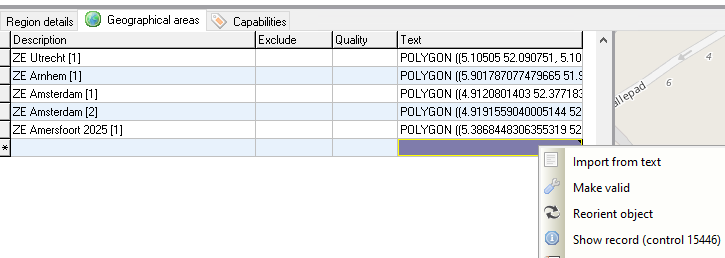
The zero-emission zones are now set as regions in Transpas. In combination with capabilities, an automatic warning can be displayed when a vehicle is scheduled on a trip where a shipment is being loaded or unloaded in a zone where that vehicle is not allowed. This helps avoid violations and costly fines by always assigning the correct vehicle to the correct trip.
Instructions for setting this up are provided below.
¶ Configuring zero-emission zone warnings using capabilities
Create a capability called zero-emission zone in the "Capabilities" screen.
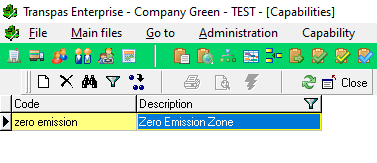
In the zero-emisson zones created as regions, add the zero-emission zone capability under the "Capabilities" tab, with the link type set to "Available".
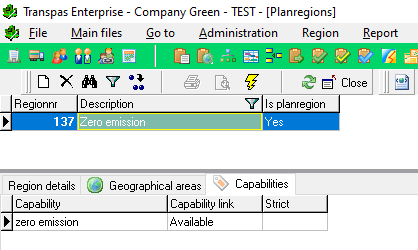
Add a capability to the vehicles that are not allowed to drive in zero-emisson zones. This can be done in two ways:
- Per vehicle: In the "Vehicles" screen, add the zero-emission zone capabilitie with the link type "Forbidden" under the "Capabilities" tab.
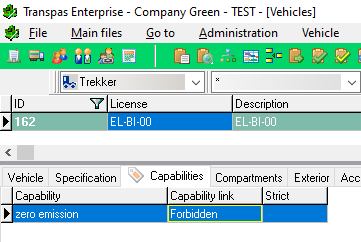
2. Per vehicle type: In the "Vehicle Types" screen, add the zero-emission zone capability with the link type "Forbidden" under the "Capabilities" tab.
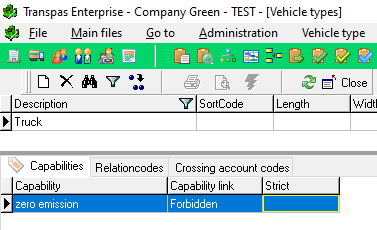
If the field “Strict” is set to No, the planner will receive a warning but can still assign the vehicle to the trip. If set to Yes, Transpas will not allow the vehicle to be assigned to that trip.
¶ Charters
An external charter is not listed in the vehicle list. Therefore, setting capabilities for external charters works slightly differently. To configure an zero-emisson zone for a charter, look up the charter in the "Financial Relations" screen.
In the Characteristic Sets tab, fill in "Carrier" under Role. A company can optionally be selected here, but leaving the asterisk means the characteristic set applies to all companies.
In the capabilities tab, add the zero-emission zone capability and set the link type to Forbidden.
Once this charter is added to a trip, the same warning will appear as for internal vehicles.
Make sure the constraint checks are enabled. This setting can be toggled per planning group.
Navigate to Planning Groups > "Extra Parameters" tab > section Planning.
Set the following two options to Yes:
- Check constraints on plan resources
- Check constraints on plan shipment.
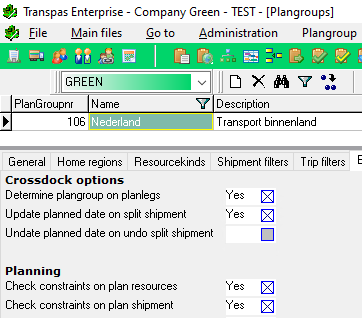
Example warning

If "Strict" is set to No or left blank when assigning the Environmental Zone characteristic, the warning will be displayed but the vehicle can still be assigned to the trip. A warning remains visible on the trip and trip activity.
